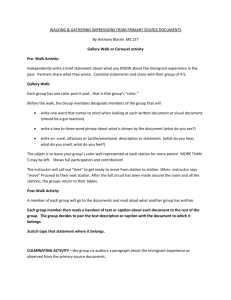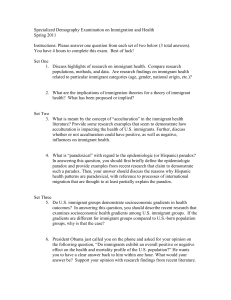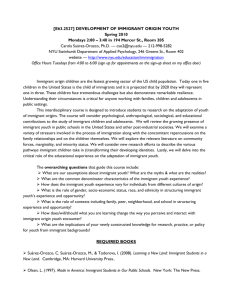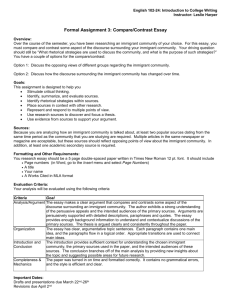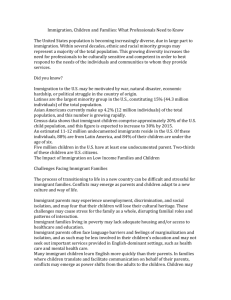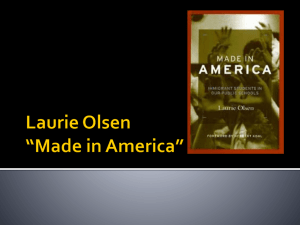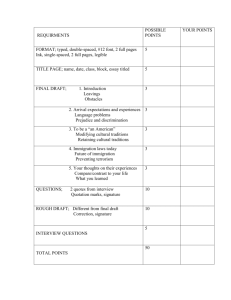All Students—Film, Novel, or Memoir Commentary
advertisement
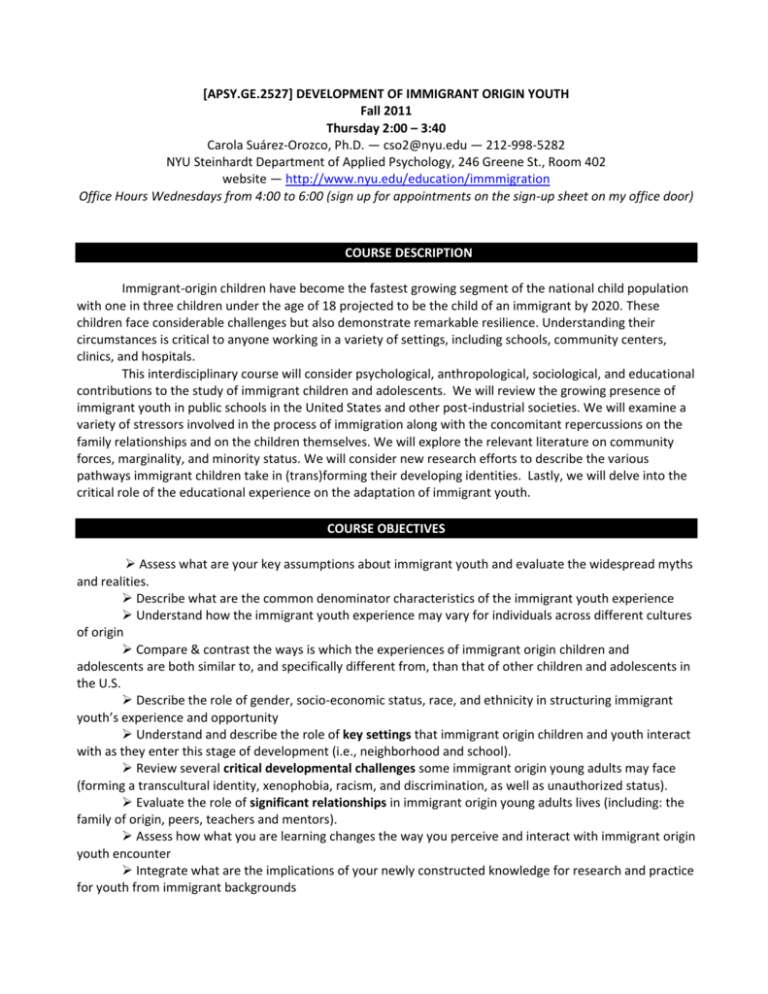
[APSY.GE.2527] DEVELOPMENT OF IMMIGRANT ORIGIN YOUTH Fall 2011 Thursday 2:00 – 3:40 Carola Suárez-Orozco, Ph.D. — cso2@nyu.edu — 212-998-5282 NYU Steinhardt Department of Applied Psychology, 246 Greene St., Room 402 website — http://www.nyu.edu/education/immmigration Office Hours Wednesdays from 4:00 to 6:00 (sign up for appointments on the sign-up sheet on my office door) COURSE DESCRIPTION Immigrant-origin children have become the fastest growing segment of the national child population with one in three children under the age of 18 projected to be the child of an immigrant by 2020. These children face considerable challenges but also demonstrate remarkable resilience. Understanding their circumstances is critical to anyone working in a variety of settings, including schools, community centers, clinics, and hospitals. This interdisciplinary course will consider psychological, anthropological, sociological, and educational contributions to the study of immigrant children and adolescents. We will review the growing presence of immigrant youth in public schools in the United States and other post-industrial societies. We will examine a variety of stressors involved in the process of immigration along with the concomitant repercussions on the family relationships and on the children themselves. We will explore the relevant literature on community forces, marginality, and minority status. We will consider new research efforts to describe the various pathways immigrant children take in (trans)forming their developing identities. Lastly, we will delve into the critical role of the educational experience on the adaptation of immigrant youth. COURSE OBJECTIVES Assess what are your key assumptions about immigrant youth and evaluate the widespread myths and realities. Describe what are the common denominator characteristics of the immigrant youth experience Understand how the immigrant youth experience may vary for individuals across different cultures of origin Compare & contrast the ways is which the experiences of immigrant origin children and adolescents are both similar to, and specifically different from, than that of other children and adolescents in the U.S. Describe the role of gender, socio-economic status, race, and ethnicity in structuring immigrant youth’s experience and opportunity Understand and describe the role of key settings that immigrant origin children and youth interact with as they enter this stage of development (i.e., neighborhood and school). Review several critical developmental challenges some immigrant origin young adults may face (forming a transcultural identity, xenophobia, racism, and discrimination, as well as unauthorized status). Evaluate the role of significant relationships in immigrant origin young adults lives (including: the family of origin, peers, teachers and mentors). Assess how what you are learning changes the way you perceive and interact with immigrant origin youth encounter Integrate what are the implications of your newly constructed knowledge for research and practice for youth from immigrant backgrounds REQUIRED BOOKS & REPORTS American Psychological Association (under review). Meeting the challenges associated with immigration: A psychological perspective - Report of the Presidential Task Force on Immigration. Washington, DC: Author. Note: Found in Week 1 of Blackboard Site Gibson, M. A. & Gándara, P. & Koyma, J. P. (Eds). (2004). School Connections: U.S. Mexican Youth, Peer, & School Achievement. New York: Teacher’s College Press. Olsen, L. (1997). Made in America: Immigrant Students in Our Public Schools. New York: The New Press. Suárez-Orozco, C. Suárez-Orozco, M., & Todorova, I. (2008). Learning a New Land: Immigrant Students in American Society. Cambridge, MA: Harvard University Press.. Note: All readings are required unless otherwise indicated! NOTE: When you are assigned a TBA (To Be Assigned) reading, you will be asked to lead a discussion in which, you teach to your colleagues the key findings covered in the readings with particular regard to any theoretical or methodological contributions. Thus, you should be ready to address: 1- what disciplinary tradition do the authors represent?: 2-who was the population?; 3-what methodology was used; 4-what were the key finding(s)?; 5-what are the particular contributions made in this reading?; 6-what are limitations (what are you left wondering about or what would future research need to address)? 7-what are the implications for research, practice, or policy? Page 2 COURSE STRUCTURE September 8th — Week One: Course Introduction— The New Immigrants García-Coll & Marks, “Why Study Children of Immigrants?” Required Mathar. Children in Immigrant Families Chart a New Path (recommended) Pew Hispanic Center. Children in Immigrant Families Chart a New Path (recommended) APA Presidential Task Force on Refugees (for reference) September 15th — Week Two: Acculturation & The Immigrant Paradox Entry Schwartz, et al., “Rethinking the Concept of Acculturation” Marks, Patton, & Coyne, “Acculturation-Related Conflict Across Generations” Fuligini, “The Intersection of Aspirations & Resources in the Development of Children…” Qin & Han, “The Achievement/Adjustment Paradox” September 22nd — Week Three: Immigrant Family Dynamics & Relationships Entry Suárez-Orozco, Bang, & Kim “Leaving Heart Behind” Louie. “Parental Sacrifices and the Obligations of Children” Faulstitch-Orellana. “Responsibilities of Children in Latino Immigrant Homes” Suárez-Orozco & Suárez-Orozco. Chapter 3 of “Children of Immigration” (suggested) September 29th — Week Four: Peer Relationships Entry Gibson et al. Chapters 1, 2, 3, & 9 of School Connections You are expected to read all of the assigned chapters and will also be assigned to read one additional chapter — 6, 7, or 8. Students will be pre-assigned responsibility for taking the lead on chapter discussions. October 6th — Week Five: Marginalization & Formulating Identity Entry Deaux. Chapter 5 of “To be an Immigrant” Suárez-Orozco. “Transnational Identities in Our Globalized Societies” Steele. “A Threat in the Air” (TBA) Suárez-Orozco & Suárez-Orozco. Chapter 4 of “Children of Immigration” (suggested) October 13th — Week Six: Ecological Contexts & Resilience Entry Film in Class—AKA Don Bonus Luthar. “Poverty and Children’s Adjustment” Garbarino. “An Ecological Perspective on the Effects of Violence on Children” Masten. “ Ordinary magic: Resilience Processes in Development” Feedback returned on Reading Entries today Page 3 October 20th — Week Seven: Race & Ethnicity Entry Morales. Chapter 1 of “Living in Spanish” Wu. Chapter 1 of “Yellow: Race in America Beyond Black & White” Olsen. Chapters 6 of Made in America Pang, Kiang, & Pak. “Asian American Students.” (TBA) Suárez-Orozco & Paez. “Latinos: The Research Agenda.” (TBA) Tormala & Deaux, “Black Immigrants to the US: Confronting & Construction of Ethnicity & Race” (TBA) Lew. “The ‘Other’ Story of the Model Minority” (TBA) October 27th — Week Eight: Unauthorized Status Entry Suárez-Orozco, et al., “Growing up in the Shadows” Yoshikawa, “Undocumented Parents and Their Young Children” Gonzales, “Learning to be Illegal” November 3rd — Week Nine: Academic Engagement & Achievement Chapter 1-Learning in a New Land Suárez-Orozco. “Achievement Motivation & Attitudes Toward School” Suárez-Orozco, Pimentel, & Martin, “The Significance of Relationships…” Kao & Tienda. “Optimism & Achievement...” (TBA) November 10th — Week Ten: Gendered Experiences Entry Lopez. Chapter 4 of Hopeful Girls, Troubled Boys: Race & Gender Disparity in Urban Ed Olsen. Chapter 6 of Made in America (TBA) Suárez-Orozco & Qin-Hillard. “…Academic Engagement: Immigrant Boys’ in Schools” (TBA) Qin-Hillard. “Gendered Experiences & Gendered Expectations” (TBA) November 17th — Week Eleven : Language Acquisition Entry Chapters 4 of Learning in a New Land Valdes. “The World Outside & Inside Schools. Language & Immigrant Children” Olsen. Chapters 4 of Made in America Carhill, Suárez-Orozco, & Páez. “Explaining English Language Proficiency…” (TBA) Lesaux, “Building Consensus…” (TBA) Portes & Hao. E Pluribus Unum: Bilingualism & Loss of Language in the 2nd Generation” (TBA) November 24th THANKSGIVING December 1st — Week Twelfth: Immigrant Students & Schools Entry Guest Lecture— Dr. Margary Martin Chapter 3 of Learning in a New Land Phelan, Davidson, & Yu. “Students’ Multiple World” Olsen. Chapters 2 & 3 of Made in America Page 4 All Students—Film, Novel, or Memoir Commentary due today December 8th — Week Thirteen: Case Study Discussions Entry Chapters 5-8 of Learning in a New Land You will be select (or be assigned) a contributing factor lens (structural; relational; school; language) as well as implicational (counseling; education; research; policy) perspective to be taking as you read the case studies and should be prepared to contribute to the discussion making reference to what you learned by reading these chapters. December 15th — Week Fourteen: Practice & Research Implications Suárez-Orozco, Carhill, & Chuang, “Immigrant Children: Making a New Life” Educational Practice: Moll & González. “Engaging Life: A Funds-of-Knowledge Approach to Multicultural Ed” Nieto. Chapter 7 of Light in Their Eyes: Creating Multicultural Learning Communities” (TBA) Suárez-Orozco, Alexandersson, Martin, et al. “Promising Practices: Preparing the Children of Immigrants…” Psychological Practice (TBA ) APA Immigration Task Force Considerations for the Field (Immigrant Populations in Clinical Contexts Suárez-Orozco & Suárez-Orozco. “Educating Latino Immigrants for the 21st Century” (TBA) Research: (TBA) APA Immigration Task Force Considerations for the Field (Considerations for the Field) Boyce & Fuligini. “Issues for Developmental Research…” Beale-Spencer & Dornbusch. “Challenges in Studying Minority Youth.” Final Paper due today CLASS REQUIREMENTS & EVALUATION POLICY Your grade for the course is based on your engagement with and mastery of the concepts underlying immigrant youth development. In order for you to benefit from this class, you must take time to deeply reflect upon the material presented during lectures, class discussions, and in the assigned reading. You are expected to attend all classes. As a courtesy to your classmates and me, please be punctual. More than one absence or a pattern of arriving late or leaving early will lower your grade. Cell phones are not to be on in class. Texting during lectures and discussions is also distracting and means you are not fully engaged in what is going on in class so please do not engage in this activity. Laptops are to be used exclusively for notetaking related to class—using laptops for other activities reflects that you are not fully engaged in class and will lead to a lower class participation grade. You are expected to complete reading assignments before class on the dates indicated on the syllabus. In order to be well prepared for the discussion, each week you will be required to prepare a reading entry for at least one of the readings. Page 5 Weekly Reading Entry: [30 % of final grade] Beginning the second week of class, you will be required to write a reading entry on ONE of the readings for the week. Each week, choose at least one reading and briefly summarize the take-home messages of the reading. You may wish to include a salient quote or quotes that you may incorporate into a future paper or regarding which you would like to react to in class discussion. Master’s students Most class weeks (except where otherwise indicated) 1-Pick at least ONE reading and bullet responses to the following questions o What are the key take home messages of the reading? o How is the reading consistent (or inconsistent) with your experience? o How is the reading consistent (or inconsistent) with what you are learning in your class? o Does the writer provide a convincing argument and chain of evidence? o Are you left with unanswered questions? o How does this reading inform your current (or future) work? 2-For the each of the remaining required readings summarize the take home message in a bullet or two. These reading entries MUST be turned in at the end of each class or they will be considered late. The point of this exercise is to teach you how to think deeply about readings and to come fully prepared for discussions. You may miss ONE of these weekly entries without it affecting your grade. The reading reflections will not be accepted late unless there are exceptional circumstances. These will be graded with a +;; or -. An overall portfolio of responses of +s is equal to an A; an overall portfolio of responses of s is equal to a B+; and an overall portfolio of responses of -s is equal to a C (or potentially lower in which case I will ask to see you). (You may raise your overall Reading Entry grade by extra of the lengthier entries per week). You will receive feedback on a portfolio of these reading entries at an early mid-point range of the semester and then again at the end. (Note that there is a rubric available on Blackboard to guide you for the grading criteria for this assignment.) Doctoral students are required to make weekly entries ON EACH OF THE REQUIRED readings using Zotero or Endote or RefWorks. Include in your brief summary for each reading: o Theoretical frame? o Methodological approach? o Research population? Key finding (s)? o Implications of the reading for future directions in practice, research, or policy? o You can also include any salient quote(s) that you might incorporate into a future paper or regarding which you would like to react to in class discussion. o Also include keywords that will make it easy for you to find the article should you need to refer to it in the future. Note that Master’s students who intend to go onto doctoral studies may choose this Zotero/Endote/RefWorks option rather than to do the weekly reading summary as noted above if you would like to get into the practice of using this excellent bibliographic tool.) Class discussions: [20 % of final grade] Class participation plays a critical role in your success in this course. You will be assigned responsibility to lead discussions on specific articles. You are also encouraged to bring to class relevant examples of current media representations of the immigration debate—please start out each class by bringing in news stories that caught your attention during the previous week. Class participation provides the opportunity to practice speaking and persuasive skills—as well as the ability to listen. Effective class comments may integrate material from this and other courses, draw on realPage 6 world experiences and observations, address questions raised by others, or pose new questions to the class. High quality participation involves knowing when to speak and when to listen or allow others to speak. Take the time to think about how your comments will be received; comments that are vague, repetitive, unrelated to the current topic, or without sufficient foundation are distracting and do not move forward the discussion. Those that are insensitive to other students in the class or are framed as personal attacks are unacceptable under any circumstances. Below are the criteria for assessment: Strong Contributor: Contributions in class reflect thorough preparation. Ideas offered are substantive and provide good insights as well as direction for the class. Challenges are well substantiated and are persuasively presented in a respectful manner. If the strong contributor person were not a member of the class, the quality of discussion would be diminished considerably. Adequate Contributor: Contributions in class reflect satisfactory preparation. Ideas offered are sometimes substantive, provide generally useful insights but seldom offer a new direction for the discussion. Challenges are sometimes presented, fairly well substantiated and are sometimes persuasive. If the adequate contributor were not a member of the class, the quality of discussion would be somewhat diminished. Non-Participant: The non-participant says little or nothing in class. Hence, there is not an adequate basis for evaluation. If this person were not a member of the class, the quality of discussion would not be changed. Unsatisfactory Contributor: Contributions in class reflect inadequate preparation. Ideas offered are seldom substantive, provide few if any insights and are often tangential and off track. Comments are insensitive to other students in the class. If this person were not a member of the class, valuable time would be saved and the comfort level of the class would be elevated. LOW-TECH ‘FACEBOOK’: By the second week of class, please bring an 8 ½ X 11” page with a copy of your NYU ID (or another photo if you like) and a one paragraph description of yourself—what program are you in?; where are you from?; why are you taking this class?; what are you hoping to learn? The purpose of this assignment is to help me get to know you—this is my low-tech version of ‘Facebook.’ This is an ungraded but required assignment; failing to turn this in will count against your participation grade. Film, Novel, or Memoir Commentary: [20 % of final grade] You will be required to view or read at least one film, novel or memoir, which portrays the immigrant experience. In writing the 2-3 page commentary, only briefly recap the narrative of the film or novel in order to orient the reader. You focus should be on reflecting upon how the material covered in lectures, discussions, and readings helped (or did not help) to place in perspective the experiences of the protagonists contending with issues of migration. This commentary is due on December 1st . You may select from the list below or you may select other films, plays, memoirs, or novels that portray the immigrant experience. Suggested films or documentaries include: AKA Don Bonus American Me Bread & Chocolate Dirty Pretty Things Grand Torino El Norte Farmingdale The Joy Luck Club Journey of Hope La Americana L' America Page 7 Mi Familia Mi Vida Loca Real Women Have Curves Selena Sin Nombre Those Who Remain (Los Que Se Quedan) The New Americans (PBS series) The Last Train Home Under the Same Moon (A Bajo de la Misma Luna) The Visitor Zoot Suit Recommended novels, memoirs, or series of short stories include: The Accidental Asian (1998) by Eric Liu [Chinese origin] Always Running: Mi Vida Loca (1994) by Luis Rodriguez [Mexican American origin] American Son (2001) by Brian Ascalon Roley [Filipino origin] Bodega Dreams (2000) by Ernesto Quiñonez [New Yorkan] Breath, Eyes, Memory (1995) by Edwidge Danticat [Haitian origin] Brother, I’m Dying (2007) by Edwidge Danticat [Haitian origin] Dreaming in Cuban (1992) by Christina Garcia [Cuban origin] Do They Know I am Always Running? (2010) by David Corbett [Salvadorian origin] Drown (1996) by Junot Diaz [Dominican origin] A Feather on the Breath of God (1995) by Sigrid Nuñez [Mixed Ethnicity—Chinese-Panamanian & German] A Free Life (2007) by Ha Jin [Chinese origin] Hope and Other Dangerous Pursuits (2005) by Laila Lalami [Undocumented Moroccans to Spain] How the Garcia Girls Lost Their Accent (1992) by Julia Alvarez [Dominican origin] Hunger (1998) by Lan Samantha Chang [Chinese origin] Hunger of Memory (1983) by Richard Rodriguez [Mexican origin] Imagining America: Stories From the Promised Land [1991] Edited by Wesley Brown & Amy Ling. Interpreter of Maladies (1998) by Jhumpa Lahiri [Indian origin] The Joy Luck Club (1989) by Amy Tan [Chinese origin] Kife Kife Tomorrow (2006) by Faiza Guéne [North Africans in Paris] Lost in Translation (1989) by Eva Hoffman [Polish origin in Canada] Migrant Souls. (1990) by Arturo Islas [Mexican/Texan Border] Mona in the Promised Land (1996). By Gish Jen. [Chinese origin] Monkey Bridge (1997) by Lan Cao [Vietnamese origin] The Namesake (2003) by Jhumpa Lahiri [Indian origin]. Native Speaker (1995) by Chang-Rae Lee [Korean origin] Nobody’s Son (1998) by Luis Alberto Urrea [Tijuana origin] Saffron Sky: A Life Between Iran & America by Gelareh Asayesh [Iranian origin] When I was Puerto Rican (1993) by Esmeralda Santiago [Puerto Rican] White Teeth (2000) by Zadie Smith [Caribbean & Pakistani in London] FINAL PAPER [30% of course grade] (Due the last day of class—December 15th.) Note: if you would like to receive my comments, you should attach a self-addressed envelope to the final paper when you turn it in. Page 8 Masters Students—Learning from Immigrant Adolescents: Pick a topic of interest that you want to learn more about by having a conversation with two immigrant origin adolescents. You will be given a copy of a protocol from the LISA project from which you can pick questions or you may develop a series of questions of your own upon which to a conversation with 3 adolescents. Develop a 7 to 10 page paper in which you cover: What did you set out to understand? Who did you interview? What did you expect (based on the readings, lectures, or class discussion—bring in references!)? What did you learn from your informants? Is what you learned consistent or inconsistent with what you expected? What did you learn from your informants? Is what you learned consistent or inconsistent with what you expected? Attach the interview protocol your paper. Papers are graded according to a rubric found on the course Blackboard site, which should guide you in the formulation of your paper. Doctoral Students—Term Paper: You will be required to write a paper on a topic of your choice. You may choose to write about topics relevant to this course that either have research, clinical, educational, or policy implications. The paper should be 12 to 15 double-spaced pages in length. The format for footnotes, references, etc. should follow an APA format. The final submission should be a well-written and polished document without typographical, grammatical, or spelling errors. This paper should be on a subject that you find of particular interest on a topic agreed to with me. Select a format and project that is most useful for you in order to you forward from where you are currently in your academic professional trajectory. Below are 3 suggested formats for your paper: Literature Review: Students who opt to write a review of the literature should include: (1) an introduction to the theoretical context of the research topic; (2) the formulation of specific research questions guiding the literature review; (3) a review of the relevant empirical literature; (4) a critique of the state of knowledge on the topic; (5) and a discussion of needs for further research. Students may model their work on articles published in review journals such as Review of Educational Research or the Annual Review series (Psychology, Sociology, Anthropology, Political Science, etc.). This option is intended to allow students to familiarize themselves with academic studies and policy research on an issue of their choice. The exercise may be treated as a chance to develop a strong foundation in the student’s area of interest. It may also serve as the basis for a dissertation proposal. Experiential: This project would require you to select a particular topic that you wish to explore in depth. You would be expected to include the following: (1) What are the myths and assumptions about the topic (per the popular culture’s as well as your own); (2) What does the research literature tells us about the topic? Make reference to readings done in class but also bring in other readings you pursue for this project; (3) Develop an interview protocol and interview 3 students on the their experience and perspective related to the topic; (4) Discuss what you have learned and how your interviewee’s experiences converge and diverge with what you expected; (5) If you were to develop a dissertation or research project on this topic, what would your research questions be and how would you go about tackling the topic? Research Proposal: Students opting to write a research proposal should include: (1) a review of the relevant literature; (2) a critique or synthesis of the theoretical foundations; (3) formulation of the research problem(s) and/or hypotheses to be tested; (4) a justification of a problem and/or hypotheses. Data sources and research designs are expected in the proposal, but they can be brief. The option is intended as a first step toward submitting as a preliminary dissertation proposal or for dissertation funding. The format of this assignment should conform to the actual application requirements of funding agencies or the actual dissertation proposal format. (Students may refer to guidelines contained in a selection from “How to Prepare a Research Proposal: Guidelines for Funding and Dissertations in the Social and Behavioral Sciences” by D. Krathwol. Students may also find the suggestions for writing proposals located on the Social Science Research Council’s website to be helpful (“The Art of Writing Proposals,” by A. Przeworski and F. Salomon, http://www.ssrc.org.artpropl.htm) Page 9 Students with Disabilities If you need an accommodation due to a chronic, psychological, visual, mobility and/or learning disability, or are deaf or hard of hearing you should be registered with the Moses Learning Center at 719 Broadway, 2nd Floor (212-998-4980), see: www.nyu.edu/csd http://www.nyu.edu/life/safety-healthandwellness/students-with-disabilities.html. Please let me know, and I will work with you according to your accommodation plan. Lecture notes are generally available before class time and you may tape lectures as well. Please make an appointment with me if you need any additional accommodations—I will be happy to work with you to meet your needs. Academic Honesty Plagiarism is a very serious form of both cheating and intellectual theft. In some cases there is clear intent and at others academic sloppiness. In either case, plagiarism may result in failure of the assignment of the course as well as a referral to the Dean of Student Services. Please refer to the NYU Steinhardt’s Statement on Academic Integrity: http://steinhardt.nyu.edu/policies/academic_integrity In order to avoid plagiarism cases, you must always give credit whenever you use: ~ another person’s idea, opinion, or theory; ~ any facts, statistics, graphs, drawings—any pieces of information—that are not common knowledge; ~ quotations of another person’s actual spoken or written words; or ~ paraphrase of another person’s spoken or written words. Should you ever have doubts, please consult the following web sites in order to clarify ambiguities that could lead to accusations of plagiarism: http://www.northwestern.edu/uacc/plagiar.html or http://www.princeton.edu/pr/pub/integrity/pages/plagiarism.html Page 10

